Nursing Assignment: Adrenalectomy, Cushing's Syndrome, and Care
VerifiedAdded on 2020/05/16
|9
|2558
|61
Report
AI Summary
This nursing assignment analyzes the case of a 40-year-old female, Susan, diagnosed with Cushing's syndrome due to a benign tumor on the right adrenal gland, who underwent a laparoscopic right adrenalectomy. The report delves into the etiology and pathophysiology of Cushing's syndrome, which is characterized by excessive cortisol levels, often caused by adrenal tumors or ACTH-producing pituitary adenomas. It discusses the hormonal cascade involved, the signs and symptoms, including moon face, truncal obesity, and hypertension, and how Susan's clinical manifestations align with the condition's pathophysiology. The assignment further examines Susan's post-operative vital signs, highlighting the importance of monitoring respiratory rate, blood pressure, and temperature, and emphasizes the need for ABCDE management (airway, breathing, circulation, drips/drains/dressings, and extras). The report stresses the significance of addressing Susan's diabetes and high BMI, implementing stress dose steroids, and managing potential complications such as hypertension, hyperkalemia and the risk of venous thromboembolic disease. It also underscores the necessity of a multidisciplinary approach, including a dietician, endocrinologist, and potentially a home nurse and social worker, to provide comprehensive care and support Susan's recovery. The report concludes by emphasizing the importance of pre-operative, intra-operative, and post-operative management for better patient outcomes.
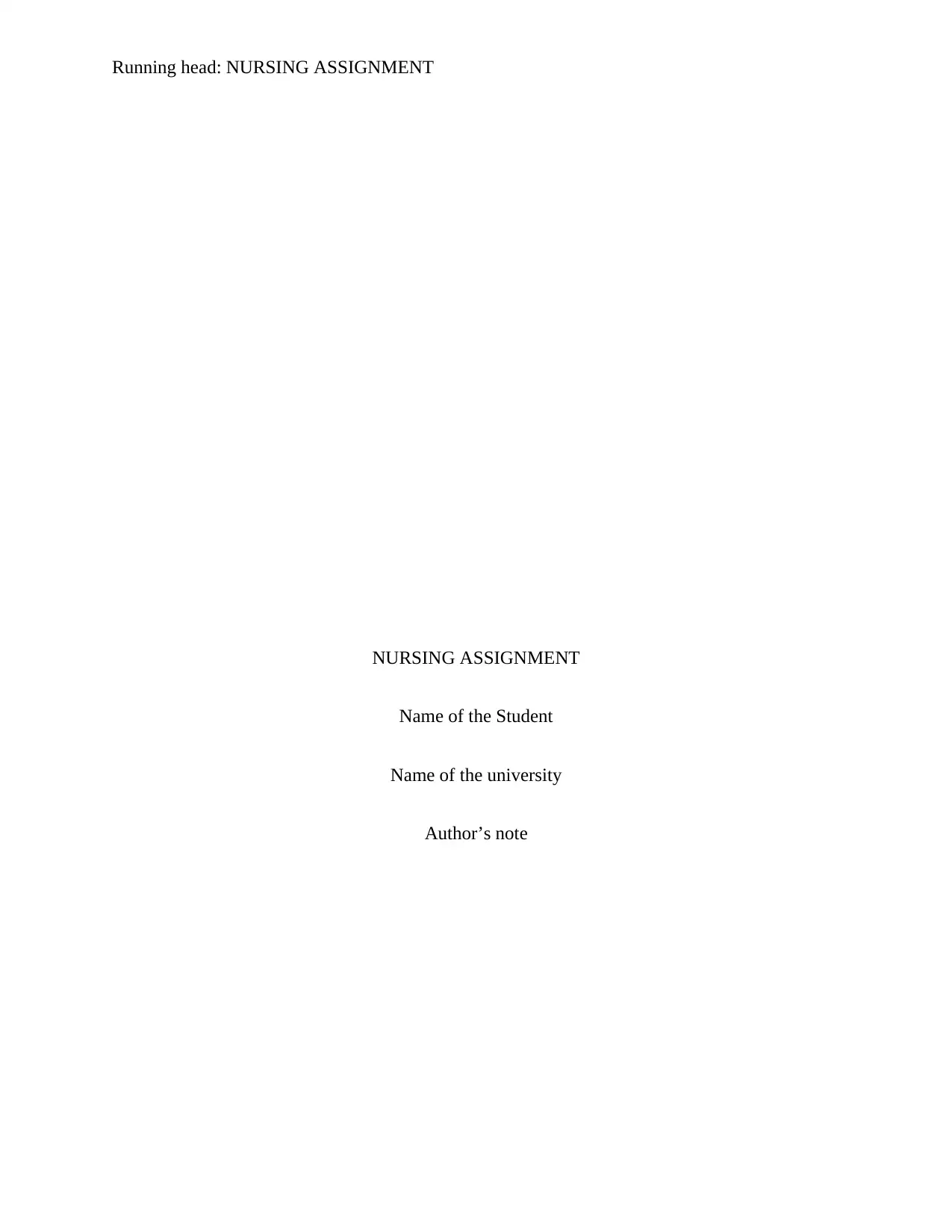
Running head: NURSING ASSIGNMENT
NURSING ASSIGNMENT
Name of the Student
Name of the university
Author’s note
NURSING ASSIGNMENT
Name of the Student
Name of the university
Author’s note
Paraphrase This Document
Need a fresh take? Get an instant paraphrase of this document with our AI Paraphraser
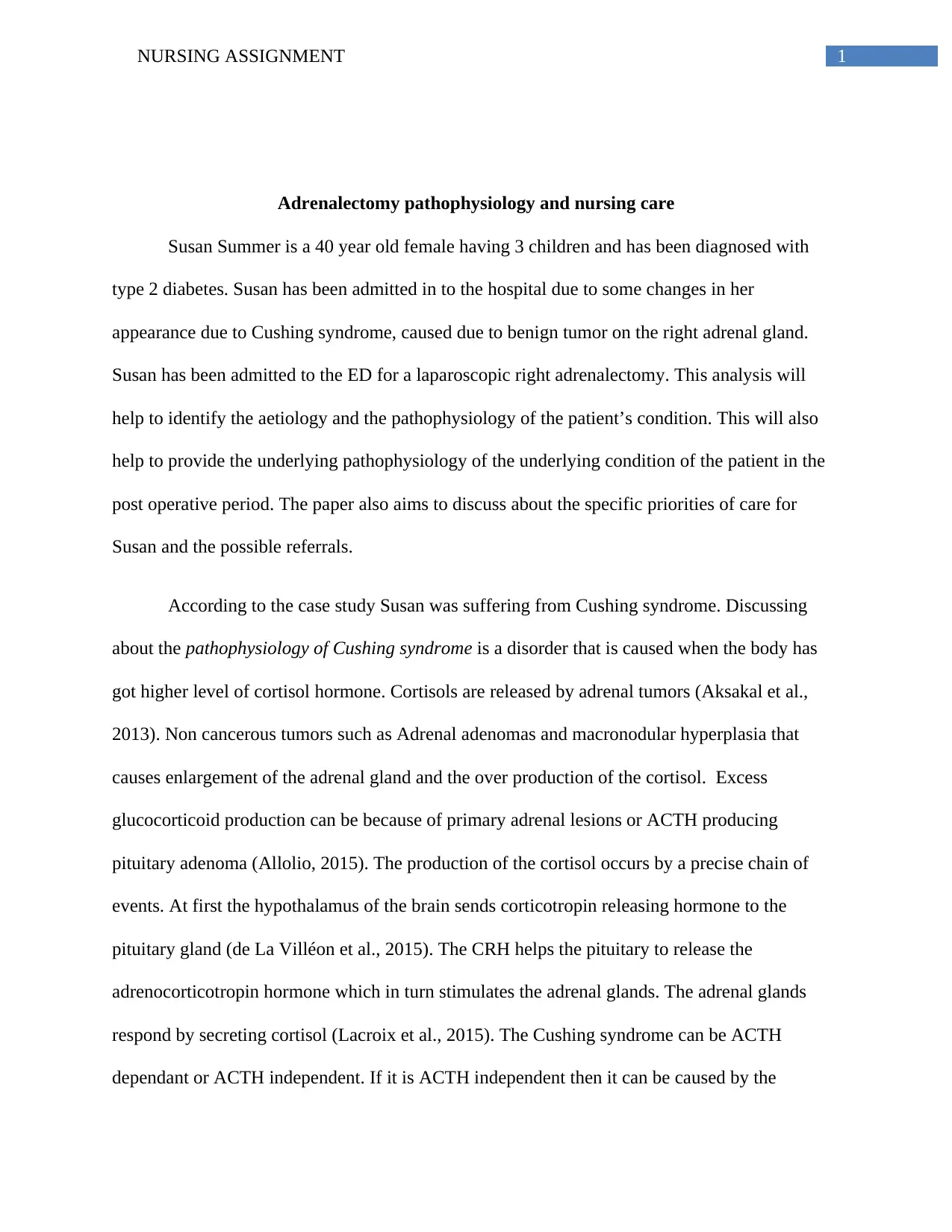
1NURSING ASSIGNMENT
Adrenalectomy pathophysiology and nursing care
Susan Summer is a 40 year old female having 3 children and has been diagnosed with
type 2 diabetes. Susan has been admitted in to the hospital due to some changes in her
appearance due to Cushing syndrome, caused due to benign tumor on the right adrenal gland.
Susan has been admitted to the ED for a laparoscopic right adrenalectomy. This analysis will
help to identify the aetiology and the pathophysiology of the patient’s condition. This will also
help to provide the underlying pathophysiology of the underlying condition of the patient in the
post operative period. The paper also aims to discuss about the specific priorities of care for
Susan and the possible referrals.
According to the case study Susan was suffering from Cushing syndrome. Discussing
about the pathophysiology of Cushing syndrome is a disorder that is caused when the body has
got higher level of cortisol hormone. Cortisols are released by adrenal tumors (Aksakal et al.,
2013). Non cancerous tumors such as Adrenal adenomas and macronodular hyperplasia that
causes enlargement of the adrenal gland and the over production of the cortisol. Excess
glucocorticoid production can be because of primary adrenal lesions or ACTH producing
pituitary adenoma (Allolio, 2015). The production of the cortisol occurs by a precise chain of
events. At first the hypothalamus of the brain sends corticotropin releasing hormone to the
pituitary gland (de La Villéon et al., 2015). The CRH helps the pituitary to release the
adrenocorticotropin hormone which in turn stimulates the adrenal glands. The adrenal glands
respond by secreting cortisol (Lacroix et al., 2015). The Cushing syndrome can be ACTH
dependant or ACTH independent. If it is ACTH independent then it can be caused by the
Adrenalectomy pathophysiology and nursing care
Susan Summer is a 40 year old female having 3 children and has been diagnosed with
type 2 diabetes. Susan has been admitted in to the hospital due to some changes in her
appearance due to Cushing syndrome, caused due to benign tumor on the right adrenal gland.
Susan has been admitted to the ED for a laparoscopic right adrenalectomy. This analysis will
help to identify the aetiology and the pathophysiology of the patient’s condition. This will also
help to provide the underlying pathophysiology of the underlying condition of the patient in the
post operative period. The paper also aims to discuss about the specific priorities of care for
Susan and the possible referrals.
According to the case study Susan was suffering from Cushing syndrome. Discussing
about the pathophysiology of Cushing syndrome is a disorder that is caused when the body has
got higher level of cortisol hormone. Cortisols are released by adrenal tumors (Aksakal et al.,
2013). Non cancerous tumors such as Adrenal adenomas and macronodular hyperplasia that
causes enlargement of the adrenal gland and the over production of the cortisol. Excess
glucocorticoid production can be because of primary adrenal lesions or ACTH producing
pituitary adenoma (Allolio, 2015). The production of the cortisol occurs by a precise chain of
events. At first the hypothalamus of the brain sends corticotropin releasing hormone to the
pituitary gland (de La Villéon et al., 2015). The CRH helps the pituitary to release the
adrenocorticotropin hormone which in turn stimulates the adrenal glands. The adrenal glands
respond by secreting cortisol (Lacroix et al., 2015). The Cushing syndrome can be ACTH
dependant or ACTH independent. If it is ACTH independent then it can be caused by the
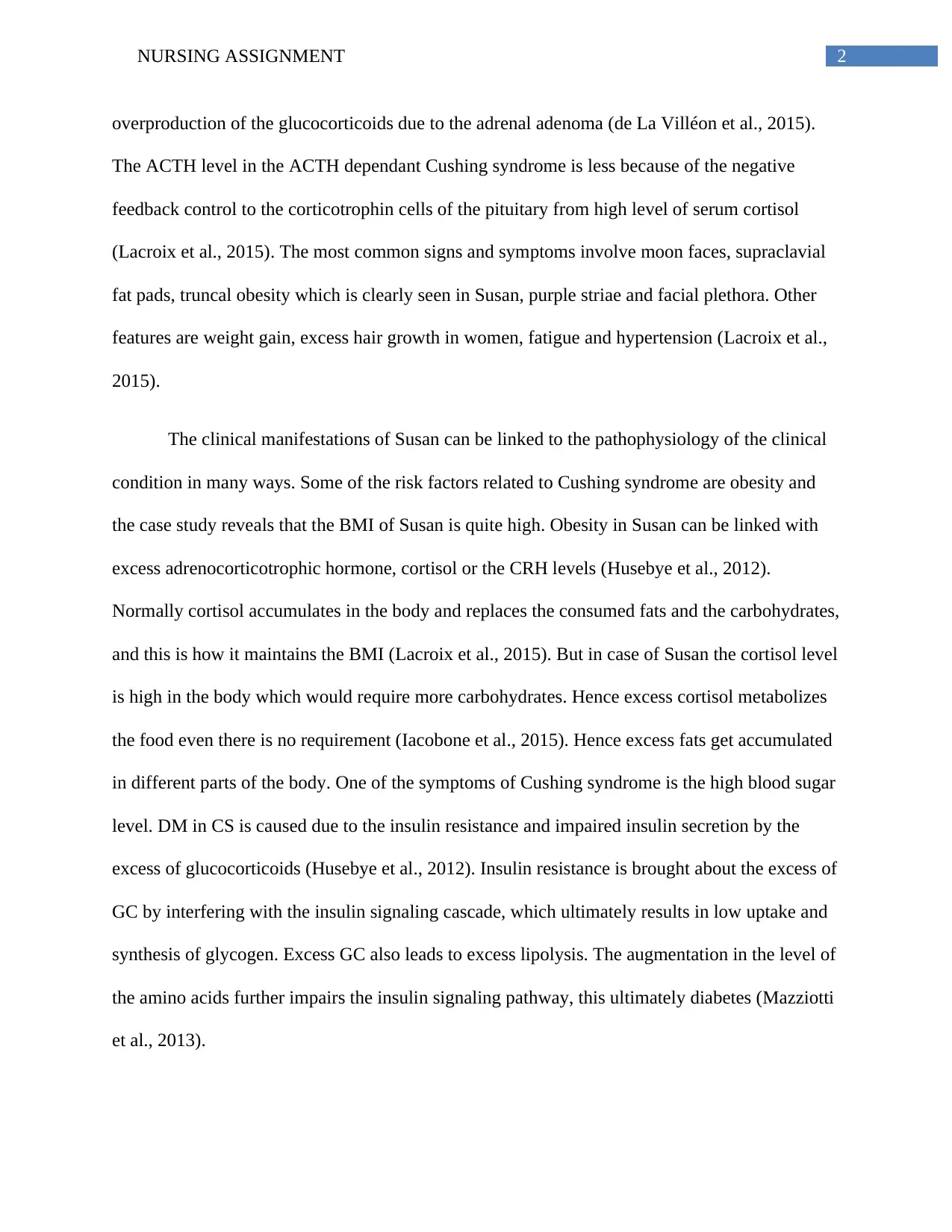
2NURSING ASSIGNMENT
overproduction of the glucocorticoids due to the adrenal adenoma (de La Villéon et al., 2015).
The ACTH level in the ACTH dependant Cushing syndrome is less because of the negative
feedback control to the corticotrophin cells of the pituitary from high level of serum cortisol
(Lacroix et al., 2015). The most common signs and symptoms involve moon faces, supraclavial
fat pads, truncal obesity which is clearly seen in Susan, purple striae and facial plethora. Other
features are weight gain, excess hair growth in women, fatigue and hypertension (Lacroix et al.,
2015).
The clinical manifestations of Susan can be linked to the pathophysiology of the clinical
condition in many ways. Some of the risk factors related to Cushing syndrome are obesity and
the case study reveals that the BMI of Susan is quite high. Obesity in Susan can be linked with
excess adrenocorticotrophic hormone, cortisol or the CRH levels (Husebye et al., 2012).
Normally cortisol accumulates in the body and replaces the consumed fats and the carbohydrates,
and this is how it maintains the BMI (Lacroix et al., 2015). But in case of Susan the cortisol level
is high in the body which would require more carbohydrates. Hence excess cortisol metabolizes
the food even there is no requirement (Iacobone et al., 2015). Hence excess fats get accumulated
in different parts of the body. One of the symptoms of Cushing syndrome is the high blood sugar
level. DM in CS is caused due to the insulin resistance and impaired insulin secretion by the
excess of glucocorticoids (Husebye et al., 2012). Insulin resistance is brought about the excess of
GC by interfering with the insulin signaling cascade, which ultimately results in low uptake and
synthesis of glycogen. Excess GC also leads to excess lipolysis. The augmentation in the level of
the amino acids further impairs the insulin signaling pathway, this ultimately diabetes (Mazziotti
et al., 2013).
overproduction of the glucocorticoids due to the adrenal adenoma (de La Villéon et al., 2015).
The ACTH level in the ACTH dependant Cushing syndrome is less because of the negative
feedback control to the corticotrophin cells of the pituitary from high level of serum cortisol
(Lacroix et al., 2015). The most common signs and symptoms involve moon faces, supraclavial
fat pads, truncal obesity which is clearly seen in Susan, purple striae and facial plethora. Other
features are weight gain, excess hair growth in women, fatigue and hypertension (Lacroix et al.,
2015).
The clinical manifestations of Susan can be linked to the pathophysiology of the clinical
condition in many ways. Some of the risk factors related to Cushing syndrome are obesity and
the case study reveals that the BMI of Susan is quite high. Obesity in Susan can be linked with
excess adrenocorticotrophic hormone, cortisol or the CRH levels (Husebye et al., 2012).
Normally cortisol accumulates in the body and replaces the consumed fats and the carbohydrates,
and this is how it maintains the BMI (Lacroix et al., 2015). But in case of Susan the cortisol level
is high in the body which would require more carbohydrates. Hence excess cortisol metabolizes
the food even there is no requirement (Iacobone et al., 2015). Hence excess fats get accumulated
in different parts of the body. One of the symptoms of Cushing syndrome is the high blood sugar
level. DM in CS is caused due to the insulin resistance and impaired insulin secretion by the
excess of glucocorticoids (Husebye et al., 2012). Insulin resistance is brought about the excess of
GC by interfering with the insulin signaling cascade, which ultimately results in low uptake and
synthesis of glycogen. Excess GC also leads to excess lipolysis. The augmentation in the level of
the amino acids further impairs the insulin signaling pathway, this ultimately diabetes (Mazziotti
et al., 2013).
⊘ This is a preview!⊘
Do you want full access?
Subscribe today to unlock all pages.

Trusted by 1+ million students worldwide
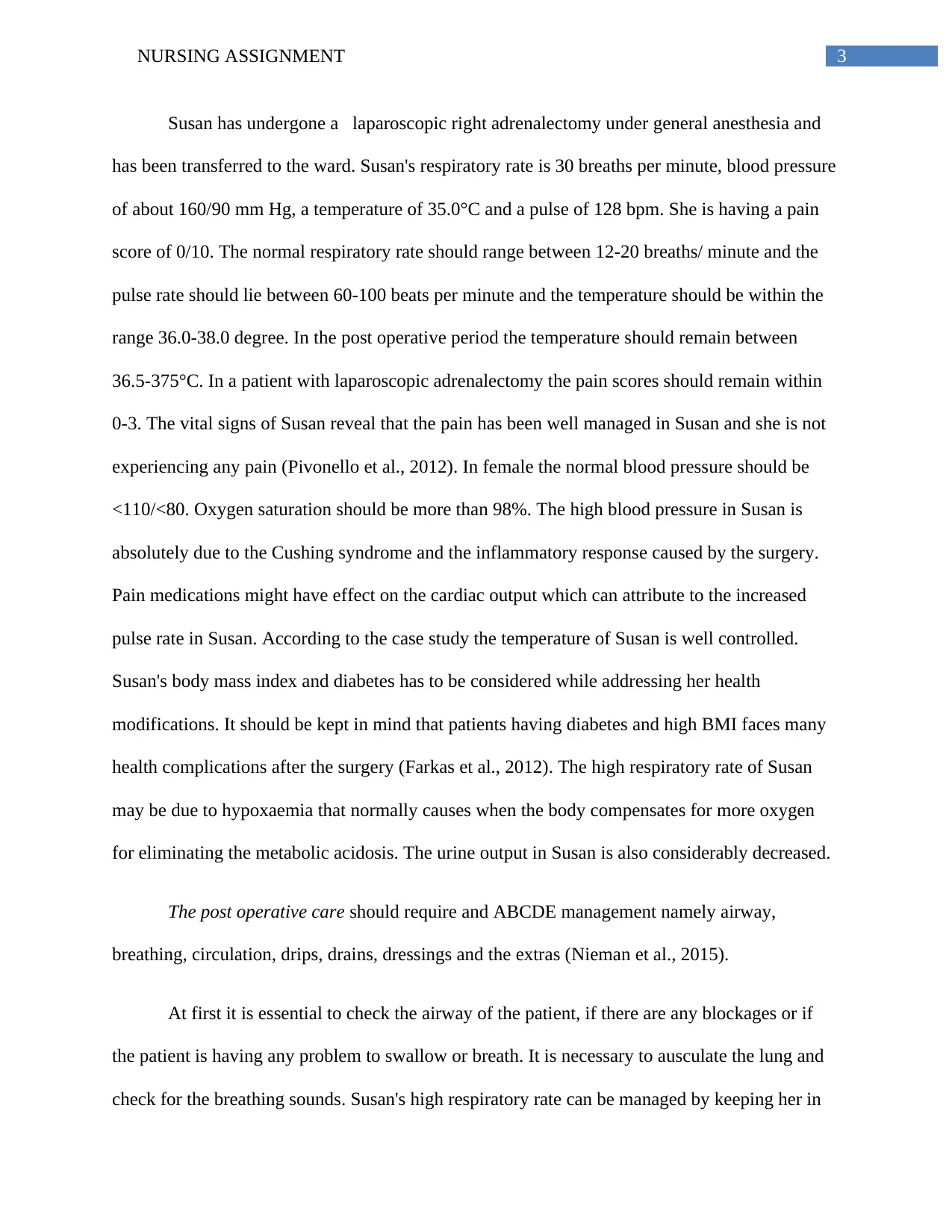
3NURSING ASSIGNMENT
Susan has undergone a laparoscopic right adrenalectomy under general anesthesia and
has been transferred to the ward. Susan's respiratory rate is 30 breaths per minute, blood pressure
of about 160/90 mm Hg, a temperature of 35.0°C and a pulse of 128 bpm. She is having a pain
score of 0/10. The normal respiratory rate should range between 12-20 breaths/ minute and the
pulse rate should lie between 60-100 beats per minute and the temperature should be within the
range 36.0-38.0 degree. In the post operative period the temperature should remain between
36.5-375°C. In a patient with laparoscopic adrenalectomy the pain scores should remain within
0-3. The vital signs of Susan reveal that the pain has been well managed in Susan and she is not
experiencing any pain (Pivonello et al., 2012). In female the normal blood pressure should be
<110/<80. Oxygen saturation should be more than 98%. The high blood pressure in Susan is
absolutely due to the Cushing syndrome and the inflammatory response caused by the surgery.
Pain medications might have effect on the cardiac output which can attribute to the increased
pulse rate in Susan. According to the case study the temperature of Susan is well controlled.
Susan's body mass index and diabetes has to be considered while addressing her health
modifications. It should be kept in mind that patients having diabetes and high BMI faces many
health complications after the surgery (Farkas et al., 2012). The high respiratory rate of Susan
may be due to hypoxaemia that normally causes when the body compensates for more oxygen
for eliminating the metabolic acidosis. The urine output in Susan is also considerably decreased.
The post operative care should require and ABCDE management namely airway,
breathing, circulation, drips, drains, dressings and the extras (Nieman et al., 2015).
At first it is essential to check the airway of the patient, if there are any blockages or if
the patient is having any problem to swallow or breath. It is necessary to ausculate the lung and
check for the breathing sounds. Susan's high respiratory rate can be managed by keeping her in
Susan has undergone a laparoscopic right adrenalectomy under general anesthesia and
has been transferred to the ward. Susan's respiratory rate is 30 breaths per minute, blood pressure
of about 160/90 mm Hg, a temperature of 35.0°C and a pulse of 128 bpm. She is having a pain
score of 0/10. The normal respiratory rate should range between 12-20 breaths/ minute and the
pulse rate should lie between 60-100 beats per minute and the temperature should be within the
range 36.0-38.0 degree. In the post operative period the temperature should remain between
36.5-375°C. In a patient with laparoscopic adrenalectomy the pain scores should remain within
0-3. The vital signs of Susan reveal that the pain has been well managed in Susan and she is not
experiencing any pain (Pivonello et al., 2012). In female the normal blood pressure should be
<110/<80. Oxygen saturation should be more than 98%. The high blood pressure in Susan is
absolutely due to the Cushing syndrome and the inflammatory response caused by the surgery.
Pain medications might have effect on the cardiac output which can attribute to the increased
pulse rate in Susan. According to the case study the temperature of Susan is well controlled.
Susan's body mass index and diabetes has to be considered while addressing her health
modifications. It should be kept in mind that patients having diabetes and high BMI faces many
health complications after the surgery (Farkas et al., 2012). The high respiratory rate of Susan
may be due to hypoxaemia that normally causes when the body compensates for more oxygen
for eliminating the metabolic acidosis. The urine output in Susan is also considerably decreased.
The post operative care should require and ABCDE management namely airway,
breathing, circulation, drips, drains, dressings and the extras (Nieman et al., 2015).
At first it is essential to check the airway of the patient, if there are any blockages or if
the patient is having any problem to swallow or breath. It is necessary to ausculate the lung and
check for the breathing sounds. Susan's high respiratory rate can be managed by keeping her in
Paraphrase This Document
Need a fresh take? Get an instant paraphrase of this document with our AI Paraphraser
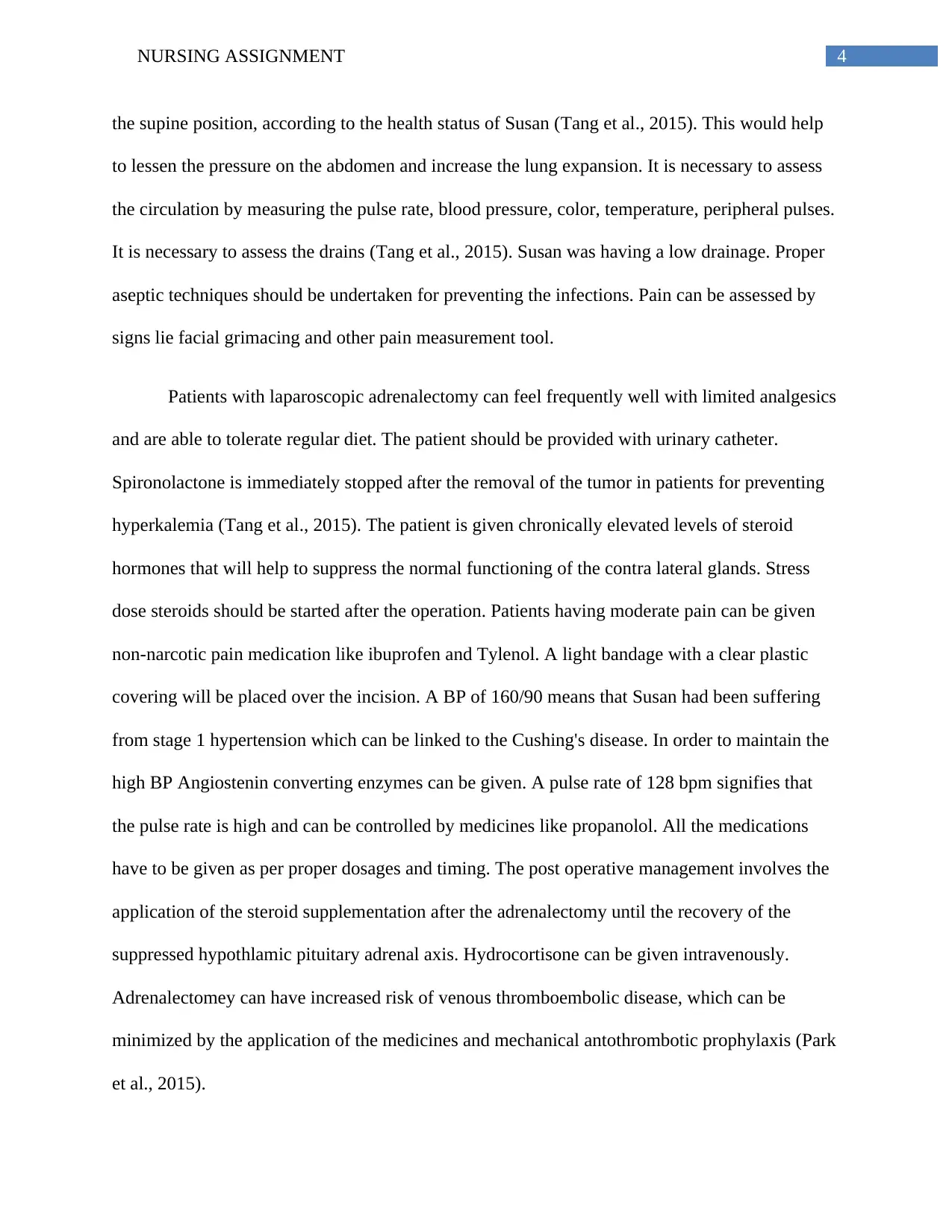
4NURSING ASSIGNMENT
the supine position, according to the health status of Susan (Tang et al., 2015). This would help
to lessen the pressure on the abdomen and increase the lung expansion. It is necessary to assess
the circulation by measuring the pulse rate, blood pressure, color, temperature, peripheral pulses.
It is necessary to assess the drains (Tang et al., 2015). Susan was having a low drainage. Proper
aseptic techniques should be undertaken for preventing the infections. Pain can be assessed by
signs lie facial grimacing and other pain measurement tool.
Patients with laparoscopic adrenalectomy can feel frequently well with limited analgesics
and are able to tolerate regular diet. The patient should be provided with urinary catheter.
Spironolactone is immediately stopped after the removal of the tumor in patients for preventing
hyperkalemia (Tang et al., 2015). The patient is given chronically elevated levels of steroid
hormones that will help to suppress the normal functioning of the contra lateral glands. Stress
dose steroids should be started after the operation. Patients having moderate pain can be given
non-narcotic pain medication like ibuprofen and Tylenol. A light bandage with a clear plastic
covering will be placed over the incision. A BP of 160/90 means that Susan had been suffering
from stage 1 hypertension which can be linked to the Cushing's disease. In order to maintain the
high BP Angiostenin converting enzymes can be given. A pulse rate of 128 bpm signifies that
the pulse rate is high and can be controlled by medicines like propanolol. All the medications
have to be given as per proper dosages and timing. The post operative management involves the
application of the steroid supplementation after the adrenalectomy until the recovery of the
suppressed hypothlamic pituitary adrenal axis. Hydrocortisone can be given intravenously.
Adrenalectomey can have increased risk of venous thromboembolic disease, which can be
minimized by the application of the medicines and mechanical antothrombotic prophylaxis (Park
et al., 2015).
the supine position, according to the health status of Susan (Tang et al., 2015). This would help
to lessen the pressure on the abdomen and increase the lung expansion. It is necessary to assess
the circulation by measuring the pulse rate, blood pressure, color, temperature, peripheral pulses.
It is necessary to assess the drains (Tang et al., 2015). Susan was having a low drainage. Proper
aseptic techniques should be undertaken for preventing the infections. Pain can be assessed by
signs lie facial grimacing and other pain measurement tool.
Patients with laparoscopic adrenalectomy can feel frequently well with limited analgesics
and are able to tolerate regular diet. The patient should be provided with urinary catheter.
Spironolactone is immediately stopped after the removal of the tumor in patients for preventing
hyperkalemia (Tang et al., 2015). The patient is given chronically elevated levels of steroid
hormones that will help to suppress the normal functioning of the contra lateral glands. Stress
dose steroids should be started after the operation. Patients having moderate pain can be given
non-narcotic pain medication like ibuprofen and Tylenol. A light bandage with a clear plastic
covering will be placed over the incision. A BP of 160/90 means that Susan had been suffering
from stage 1 hypertension which can be linked to the Cushing's disease. In order to maintain the
high BP Angiostenin converting enzymes can be given. A pulse rate of 128 bpm signifies that
the pulse rate is high and can be controlled by medicines like propanolol. All the medications
have to be given as per proper dosages and timing. The post operative management involves the
application of the steroid supplementation after the adrenalectomy until the recovery of the
suppressed hypothlamic pituitary adrenal axis. Hydrocortisone can be given intravenously.
Adrenalectomey can have increased risk of venous thromboembolic disease, which can be
minimized by the application of the medicines and mechanical antothrombotic prophylaxis (Park
et al., 2015).
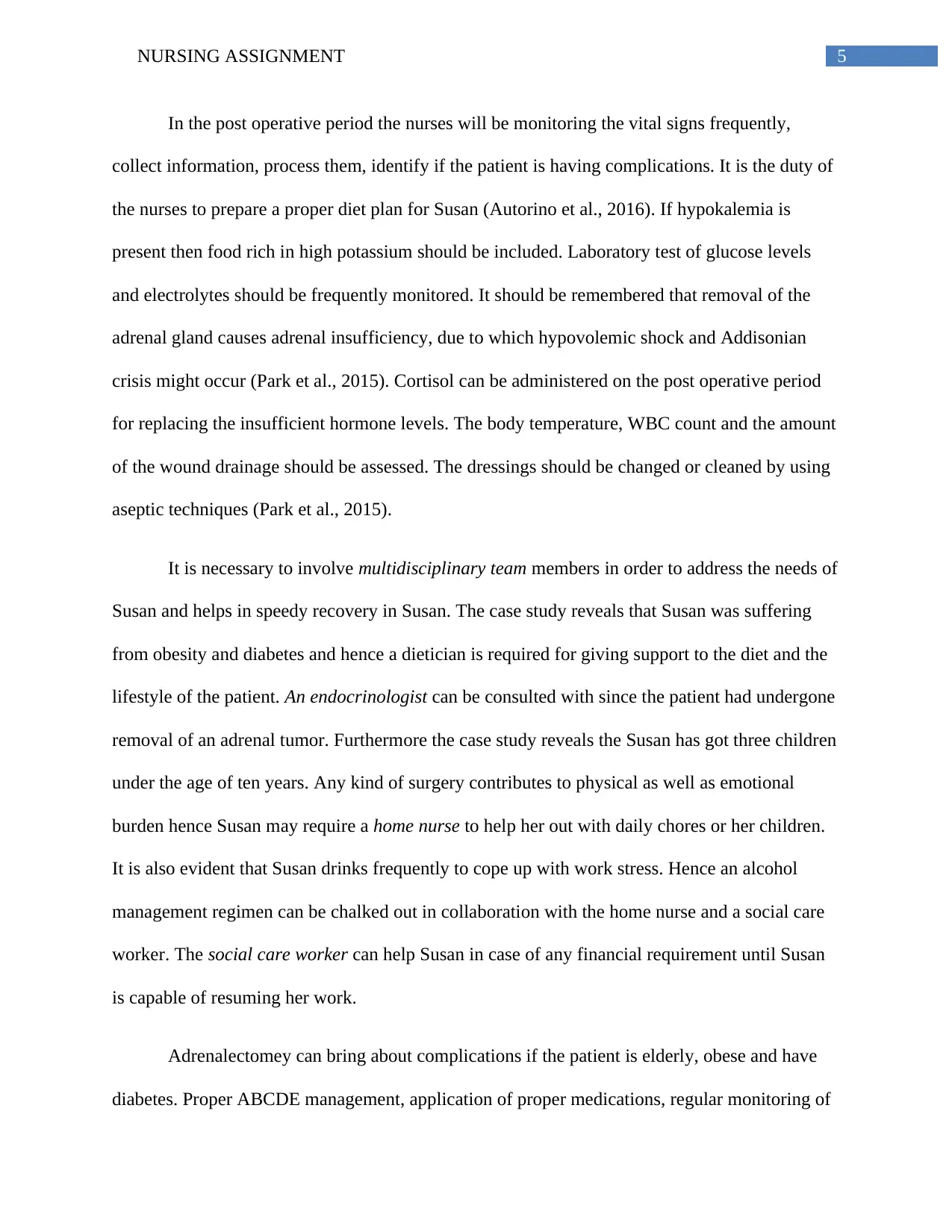
5NURSING ASSIGNMENT
In the post operative period the nurses will be monitoring the vital signs frequently,
collect information, process them, identify if the patient is having complications. It is the duty of
the nurses to prepare a proper diet plan for Susan (Autorino et al., 2016). If hypokalemia is
present then food rich in high potassium should be included. Laboratory test of glucose levels
and electrolytes should be frequently monitored. It should be remembered that removal of the
adrenal gland causes adrenal insufficiency, due to which hypovolemic shock and Addisonian
crisis might occur (Park et al., 2015). Cortisol can be administered on the post operative period
for replacing the insufficient hormone levels. The body temperature, WBC count and the amount
of the wound drainage should be assessed. The dressings should be changed or cleaned by using
aseptic techniques (Park et al., 2015).
It is necessary to involve multidisciplinary team members in order to address the needs of
Susan and helps in speedy recovery in Susan. The case study reveals that Susan was suffering
from obesity and diabetes and hence a dietician is required for giving support to the diet and the
lifestyle of the patient. An endocrinologist can be consulted with since the patient had undergone
removal of an adrenal tumor. Furthermore the case study reveals the Susan has got three children
under the age of ten years. Any kind of surgery contributes to physical as well as emotional
burden hence Susan may require a home nurse to help her out with daily chores or her children.
It is also evident that Susan drinks frequently to cope up with work stress. Hence an alcohol
management regimen can be chalked out in collaboration with the home nurse and a social care
worker. The social care worker can help Susan in case of any financial requirement until Susan
is capable of resuming her work.
Adrenalectomey can bring about complications if the patient is elderly, obese and have
diabetes. Proper ABCDE management, application of proper medications, regular monitoring of
In the post operative period the nurses will be monitoring the vital signs frequently,
collect information, process them, identify if the patient is having complications. It is the duty of
the nurses to prepare a proper diet plan for Susan (Autorino et al., 2016). If hypokalemia is
present then food rich in high potassium should be included. Laboratory test of glucose levels
and electrolytes should be frequently monitored. It should be remembered that removal of the
adrenal gland causes adrenal insufficiency, due to which hypovolemic shock and Addisonian
crisis might occur (Park et al., 2015). Cortisol can be administered on the post operative period
for replacing the insufficient hormone levels. The body temperature, WBC count and the amount
of the wound drainage should be assessed. The dressings should be changed or cleaned by using
aseptic techniques (Park et al., 2015).
It is necessary to involve multidisciplinary team members in order to address the needs of
Susan and helps in speedy recovery in Susan. The case study reveals that Susan was suffering
from obesity and diabetes and hence a dietician is required for giving support to the diet and the
lifestyle of the patient. An endocrinologist can be consulted with since the patient had undergone
removal of an adrenal tumor. Furthermore the case study reveals the Susan has got three children
under the age of ten years. Any kind of surgery contributes to physical as well as emotional
burden hence Susan may require a home nurse to help her out with daily chores or her children.
It is also evident that Susan drinks frequently to cope up with work stress. Hence an alcohol
management regimen can be chalked out in collaboration with the home nurse and a social care
worker. The social care worker can help Susan in case of any financial requirement until Susan
is capable of resuming her work.
Adrenalectomey can bring about complications if the patient is elderly, obese and have
diabetes. Proper ABCDE management, application of proper medications, regular monitoring of
⊘ This is a preview!⊘
Do you want full access?
Subscribe today to unlock all pages.

Trusted by 1+ million students worldwide
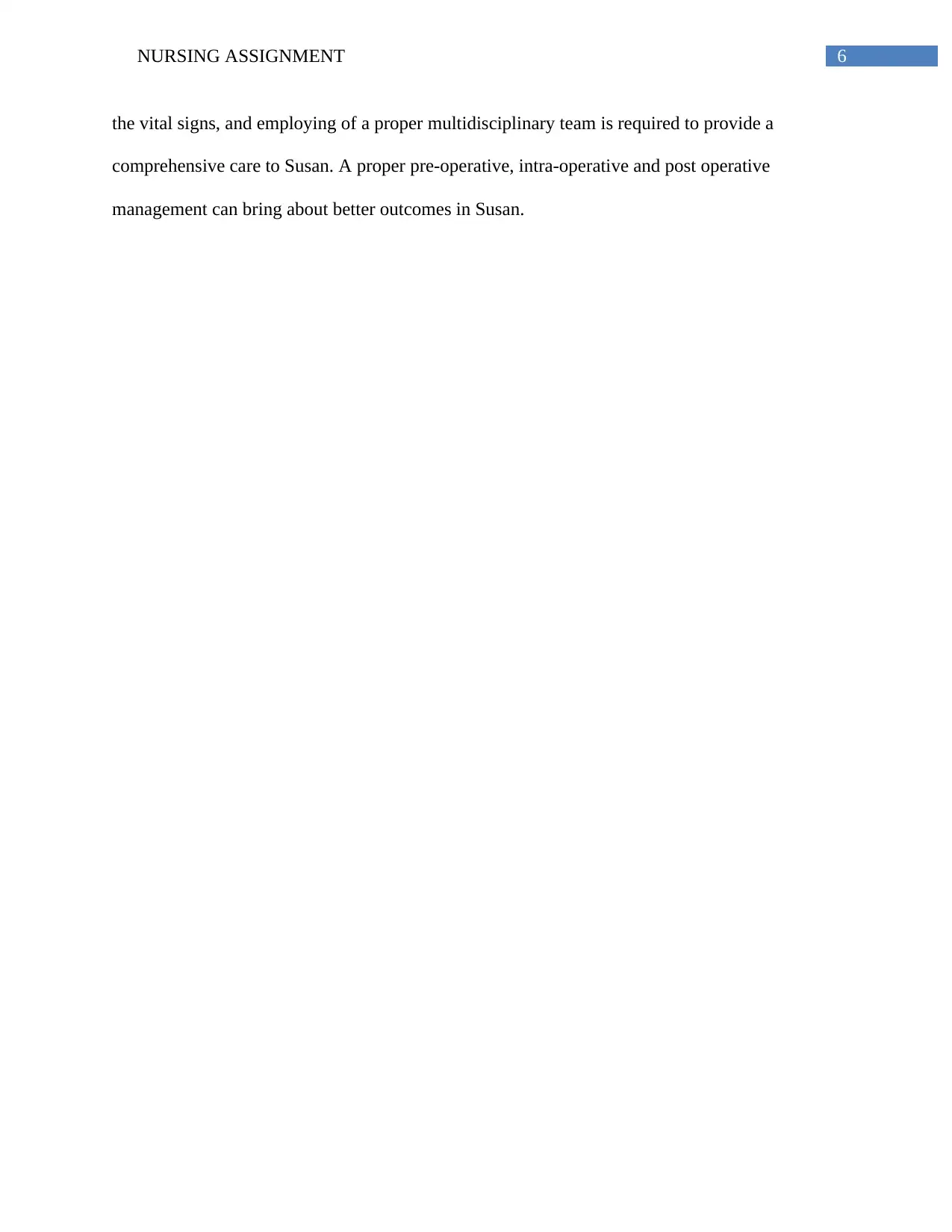
6NURSING ASSIGNMENT
the vital signs, and employing of a proper multidisciplinary team is required to provide a
comprehensive care to Susan. A proper pre-operative, intra-operative and post operative
management can bring about better outcomes in Susan.
the vital signs, and employing of a proper multidisciplinary team is required to provide a
comprehensive care to Susan. A proper pre-operative, intra-operative and post operative
management can bring about better outcomes in Susan.
Paraphrase This Document
Need a fresh take? Get an instant paraphrase of this document with our AI Paraphraser
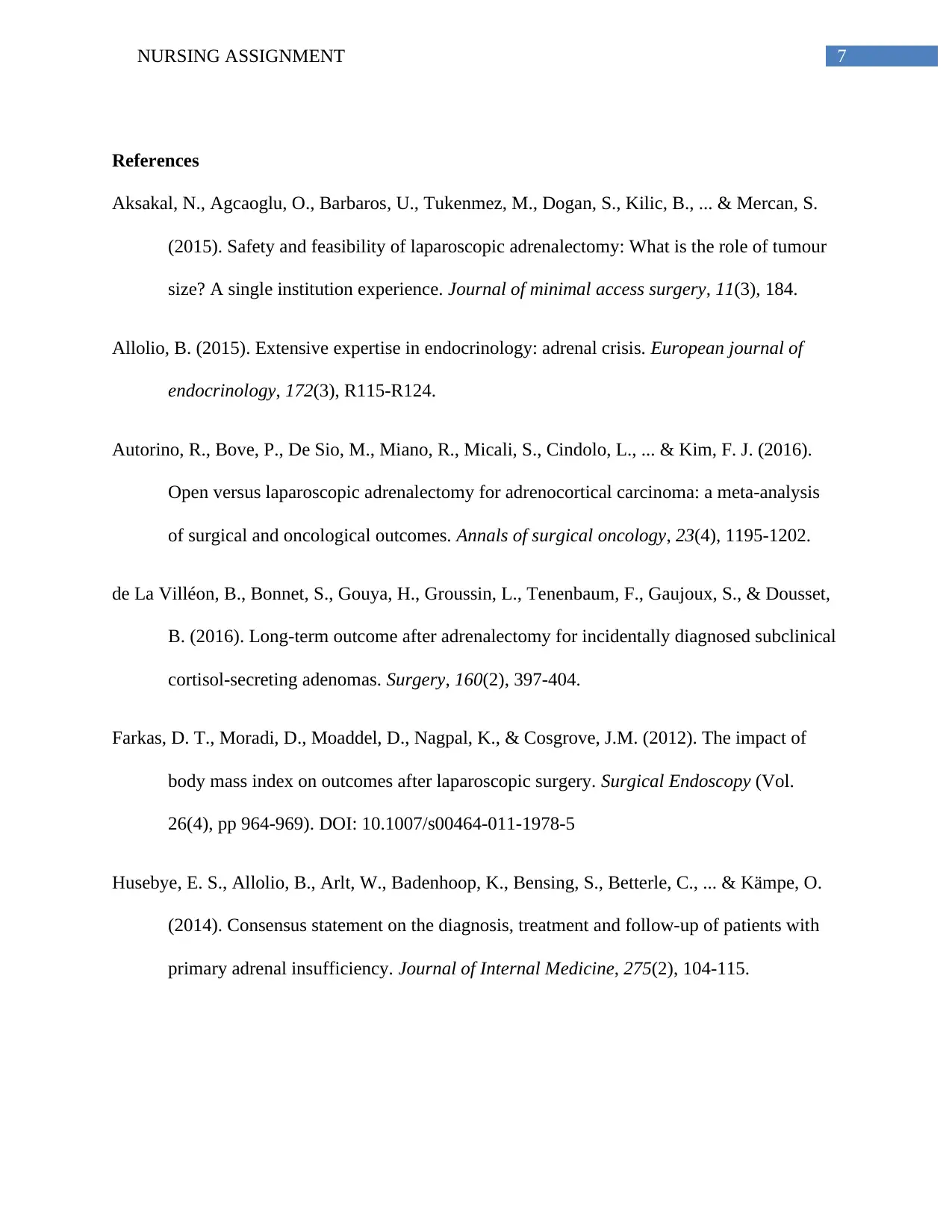
7NURSING ASSIGNMENT
References
Aksakal, N., Agcaoglu, O., Barbaros, U., Tukenmez, M., Dogan, S., Kilic, B., ... & Mercan, S.
(2015). Safety and feasibility of laparoscopic adrenalectomy: What is the role of tumour
size? A single institution experience. Journal of minimal access surgery, 11(3), 184.
Allolio, B. (2015). Extensive expertise in endocrinology: adrenal crisis. European journal of
endocrinology, 172(3), R115-R124.
Autorino, R., Bove, P., De Sio, M., Miano, R., Micali, S., Cindolo, L., ... & Kim, F. J. (2016).
Open versus laparoscopic adrenalectomy for adrenocortical carcinoma: a meta-analysis
of surgical and oncological outcomes. Annals of surgical oncology, 23(4), 1195-1202.
de La Villéon, B., Bonnet, S., Gouya, H., Groussin, L., Tenenbaum, F., Gaujoux, S., & Dousset,
B. (2016). Long-term outcome after adrenalectomy for incidentally diagnosed subclinical
cortisol-secreting adenomas. Surgery, 160(2), 397-404.
Farkas, D. T., Moradi, D., Moaddel, D., Nagpal, K., & Cosgrove, J.M. (2012). The impact of
body mass index on outcomes after laparoscopic surgery. Surgical Endoscopy (Vol.
26(4), pp 964-969). DOI: 10.1007/s00464-011-1978-5
Husebye, E. S., Allolio, B., Arlt, W., Badenhoop, K., Bensing, S., Betterle, C., ... & Kämpe, O.
(2014). Consensus statement on the diagnosis, treatment and follow‐up of patients with
primary adrenal insufficiency. Journal of Internal Medicine, 275(2), 104-115.
References
Aksakal, N., Agcaoglu, O., Barbaros, U., Tukenmez, M., Dogan, S., Kilic, B., ... & Mercan, S.
(2015). Safety and feasibility of laparoscopic adrenalectomy: What is the role of tumour
size? A single institution experience. Journal of minimal access surgery, 11(3), 184.
Allolio, B. (2015). Extensive expertise in endocrinology: adrenal crisis. European journal of
endocrinology, 172(3), R115-R124.
Autorino, R., Bove, P., De Sio, M., Miano, R., Micali, S., Cindolo, L., ... & Kim, F. J. (2016).
Open versus laparoscopic adrenalectomy for adrenocortical carcinoma: a meta-analysis
of surgical and oncological outcomes. Annals of surgical oncology, 23(4), 1195-1202.
de La Villéon, B., Bonnet, S., Gouya, H., Groussin, L., Tenenbaum, F., Gaujoux, S., & Dousset,
B. (2016). Long-term outcome after adrenalectomy for incidentally diagnosed subclinical
cortisol-secreting adenomas. Surgery, 160(2), 397-404.
Farkas, D. T., Moradi, D., Moaddel, D., Nagpal, K., & Cosgrove, J.M. (2012). The impact of
body mass index on outcomes after laparoscopic surgery. Surgical Endoscopy (Vol.
26(4), pp 964-969). DOI: 10.1007/s00464-011-1978-5
Husebye, E. S., Allolio, B., Arlt, W., Badenhoop, K., Bensing, S., Betterle, C., ... & Kämpe, O.
(2014). Consensus statement on the diagnosis, treatment and follow‐up of patients with
primary adrenal insufficiency. Journal of Internal Medicine, 275(2), 104-115.
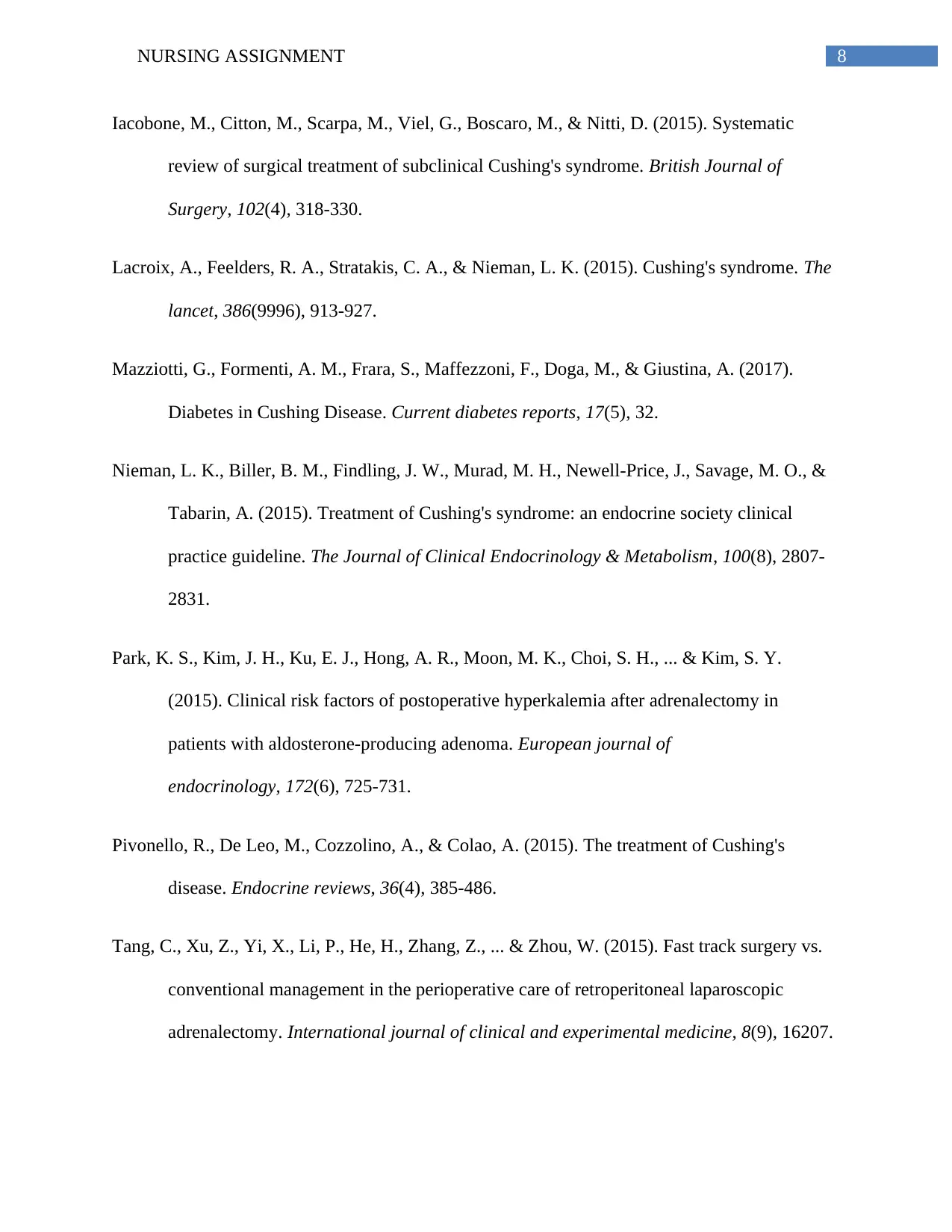
8NURSING ASSIGNMENT
Iacobone, M., Citton, M., Scarpa, M., Viel, G., Boscaro, M., & Nitti, D. (2015). Systematic
review of surgical treatment of subclinical Cushing's syndrome. British Journal of
Surgery, 102(4), 318-330.
Lacroix, A., Feelders, R. A., Stratakis, C. A., & Nieman, L. K. (2015). Cushing's syndrome. The
lancet, 386(9996), 913-927.
Mazziotti, G., Formenti, A. M., Frara, S., Maffezzoni, F., Doga, M., & Giustina, A. (2017).
Diabetes in Cushing Disease. Current diabetes reports, 17(5), 32.
Nieman, L. K., Biller, B. M., Findling, J. W., Murad, M. H., Newell-Price, J., Savage, M. O., &
Tabarin, A. (2015). Treatment of Cushing's syndrome: an endocrine society clinical
practice guideline. The Journal of Clinical Endocrinology & Metabolism, 100(8), 2807-
2831.
Park, K. S., Kim, J. H., Ku, E. J., Hong, A. R., Moon, M. K., Choi, S. H., ... & Kim, S. Y.
(2015). Clinical risk factors of postoperative hyperkalemia after adrenalectomy in
patients with aldosterone-producing adenoma. European journal of
endocrinology, 172(6), 725-731.
Pivonello, R., De Leo, M., Cozzolino, A., & Colao, A. (2015). The treatment of Cushing's
disease. Endocrine reviews, 36(4), 385-486.
Tang, C., Xu, Z., Yi, X., Li, P., He, H., Zhang, Z., ... & Zhou, W. (2015). Fast track surgery vs.
conventional management in the perioperative care of retroperitoneal laparoscopic
adrenalectomy. International journal of clinical and experimental medicine, 8(9), 16207.
Iacobone, M., Citton, M., Scarpa, M., Viel, G., Boscaro, M., & Nitti, D. (2015). Systematic
review of surgical treatment of subclinical Cushing's syndrome. British Journal of
Surgery, 102(4), 318-330.
Lacroix, A., Feelders, R. A., Stratakis, C. A., & Nieman, L. K. (2015). Cushing's syndrome. The
lancet, 386(9996), 913-927.
Mazziotti, G., Formenti, A. M., Frara, S., Maffezzoni, F., Doga, M., & Giustina, A. (2017).
Diabetes in Cushing Disease. Current diabetes reports, 17(5), 32.
Nieman, L. K., Biller, B. M., Findling, J. W., Murad, M. H., Newell-Price, J., Savage, M. O., &
Tabarin, A. (2015). Treatment of Cushing's syndrome: an endocrine society clinical
practice guideline. The Journal of Clinical Endocrinology & Metabolism, 100(8), 2807-
2831.
Park, K. S., Kim, J. H., Ku, E. J., Hong, A. R., Moon, M. K., Choi, S. H., ... & Kim, S. Y.
(2015). Clinical risk factors of postoperative hyperkalemia after adrenalectomy in
patients with aldosterone-producing adenoma. European journal of
endocrinology, 172(6), 725-731.
Pivonello, R., De Leo, M., Cozzolino, A., & Colao, A. (2015). The treatment of Cushing's
disease. Endocrine reviews, 36(4), 385-486.
Tang, C., Xu, Z., Yi, X., Li, P., He, H., Zhang, Z., ... & Zhou, W. (2015). Fast track surgery vs.
conventional management in the perioperative care of retroperitoneal laparoscopic
adrenalectomy. International journal of clinical and experimental medicine, 8(9), 16207.
⊘ This is a preview!⊘
Do you want full access?
Subscribe today to unlock all pages.

Trusted by 1+ million students worldwide
1 out of 9
Related Documents
Your All-in-One AI-Powered Toolkit for Academic Success.
+13062052269
info@desklib.com
Available 24*7 on WhatsApp / Email
![[object Object]](/_next/static/media/star-bottom.7253800d.svg)
Unlock your academic potential
Copyright © 2020–2025 A2Z Services. All Rights Reserved. Developed and managed by ZUCOL.





